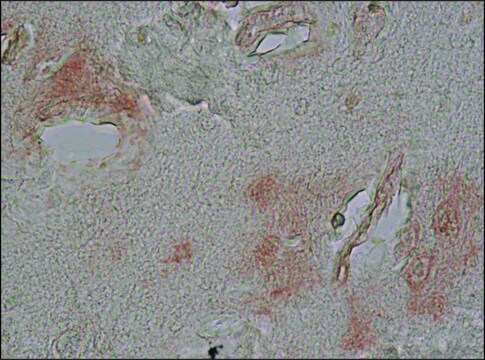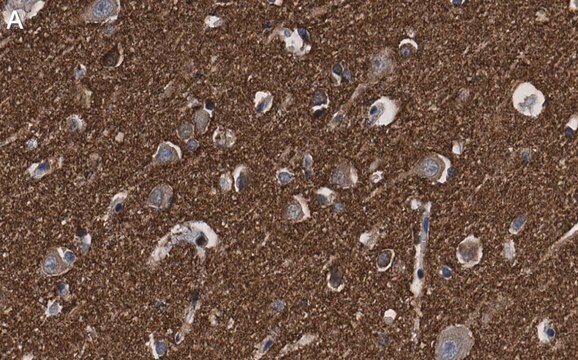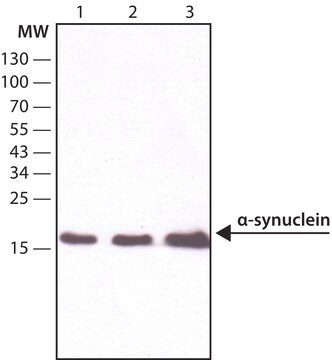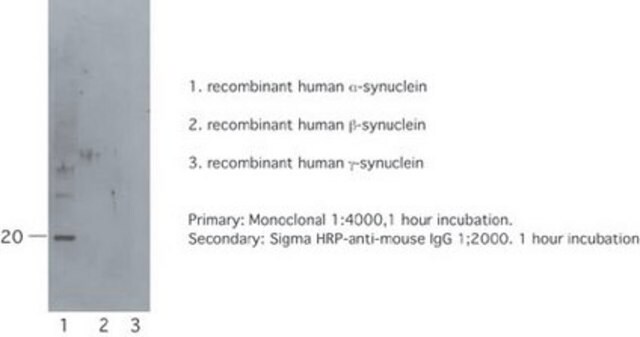General description
We are committed to bringing you greener alternative products, which adhere to one or more of The 12 Principles of Green Chemistry.This antibody is Preservative-free, produced without the harm or sacrifice of animals and exceptionally stable to allow for ambient shipping and storage if needed and thus aligns with "Waste Prevention", "Designing Safer Chemicals" and "Design for Energy Efficiency".
Click here for more information.
ZooMAb® antibodies represent an entirely new generation of recombinant monoclonal antibodies. Each ZooMAb® antibody is manufactured using our proprietary recombinant expression system, purified to homogeneity, and precisely dispensed to produce robust and highly reproducible lot-to-lot consistency. Only top-performing clones are released for use by researchers. Each antibody is validated for high specificity and affinity across multiple applications, including its most commonly used application. ZooMAb® antibodies are reliably available and ready to ship when you need them.
Specificity
Clone Syn211 is a ZooMAb® rabbit recombinant monoclonal antibody that specifically detects -Synuclein. It targets an epitope within the C-terminal region.
Immunogen
Full-length recombinant human -Synuclein.
Application
Quality Control Testing
Evaluated by Western Blotting in Human brain tissue lysate.
Western Blotting Analysis: A 1:1,000 dilution of this antibody detected -Synuclein in Human brain tissue lysate.
Tested Applications
Immunofluorescence Analysis: A 1:100 dilution from a representative lot detected -Synuclein in Human cerebral cortex and Human Parkinson′s diseased brain tissue sections.
Immunohistochemistry (Paraffin) Analysis: A 1:100 dilution from a representative lot detected -Synuclein in Human cerebral cortex tissue and Human Parkinson′s diseased brain tissue sections.
Note: Actual optimal working dilutions must be determined by end user as specimens, and experimental conditions may vary with the end user.
Target description
Alpha-synuclein (UniProt: P37840; also known as Non-A beta component of AD amyloid, Non-A4 component of amyloid precursor, NACP) is encoded by the SNCA (also known as NACP; PARK1) gene (Gene ID: 6622) in human. α-synuclein is abundantly expressed in the brain and is found in a classic amyloid fibril form within the intra-neuronal Lewy body deposits of Parkinson′s disease brains. In its monomeric form it participates in synaptic vesicle exocytosis by enhancing vesicle priming, fusion, and dilation of exocytotic fusion pores. It acts by increasing local Ca2+ release from microdomains, which is essential for the enhancement of ATP-induced exocytosis. In its multimeric form it acts as a molecular chaperone assisting in the folding of synaptic fusion components called SNAREs at presynaptic membrane. It is also involved in the regulation of dopamine release and transport. It is reported to reduce neuronal responsiveness to various apoptotic stimuli, leading to reduced caspase-3 activation. Post-translationally it can be phosphorylated, predominantly on serine residues. Phosphorylation of serine 129 is reported to be selective and extensive in synucleinopathy lesions. This phosphorylation is reported to promote insoluble fibril formation. Genetic alterations of SNCA gene are reported to result in aberrant polymerization into fibrils, which is associated with synucleinopathies. Mutations in SNCA gene are also known to cause Parkinson′s disease characterized by bradykinesia, resting tremor, muscular rigidity, and postural instability. The pathology of Parkinson s disease involves progressive loss of dopaminergic neurons in the substantia nigra and the presence of Lewy bodies in surviving neurons in various areas of the brain. This ZooMAb® recombinant monoclonal antibody, generated by our propriety technology, offers significantly enhanced specificity, Affinity™, reproducibility, and stability over conventional monoclonals. (Ref.: Huang, CC., et al. (2018). J. Cell Sci. 131(23); jcs213017; Burre, J., et al. (2010). Science. 329(5999); 1663-1667).
Physical form
Purified recombinant mouse monoclonal antibody IgG, lyophilized in PBS with 5% Trehalose, normal appearance a coarse or translucent resin. The PBS/trehalose components in the ZooMAb formulation can have the appearance of a semi-solid (bead like gel) after lyophilization. This is a normal phenomenon. Please follow the recommended reconstitution procedure in the data sheet to dissolve the semi-solid, bead-like, gel-appearing material. The resulting antibody solution is completely stable and functional as proven by full functional testing. Contains no biocide or preservatives, such as azide, or any animal by-products. Larger pack sizes provided as multiples of 25 µL.
Reconstitution
30 µg/mL after reconstitution at 25 µL per vial. Please refer to guidance on suggested starting dilutions and/or titers per application and sample type.
Storage and Stability
Recommend storage of lyophilized product at 2-8°C; Before reconstitution, micro-centrifuge vials briefly to spin down material to bottom of the vial; Reconstitute each vial by adding 25 µL of filtered lab grade water or PBS; Reconstituted antibodies can be stored at 2-8°C, or -20°C for long term storage. Avoid repeated freeze-thaws.
Other Notes
Concentration: Please refer to the Certificate of Analysis for the lot-specific concentration.
Legal Information
Affinity is a trademark of Mine Safety Appliances Co.
ZooMAb is a registered trademark of Merck KGaA, Darmstadt, Germany
Disclaimer
Unless otherwise stated in our catalog or other company documentation accompanying the product(s), our products are intended for research use only and are not to be used for any other purpose, which includes but is not limited to, unauthorized commercial uses, in vitro diagnostic uses, ex vivo or in vivo therapeutic uses or any type of consumption or application to humans or animals.









